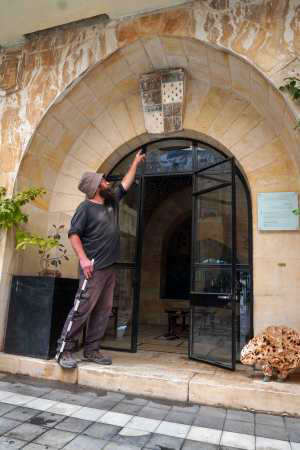
British royal coat-of-Arms
New research in Jerusalem echoes historical message from King George V and the Guinness brewery founder
A British royal and nobility coats-of-arms from the early 20th Century were identified on the walls of a Jerusalem building
The finds will be publicly displayed in the new “Between the Symbols” Exhibition
opening June 20 in the Jerusalem House of Quality
In an original research model executed by the Israel Antiquities Authority, British royal and nobility coats-of-arms were mapped and identified on early 20th Century hospital walls. For the very first time, greetings were found from famed British historical figures, including King George the Fifth, and the founder of the iconic Irish beer – Edward Cecil Guinness.
While intensively studying the coats-of-arms, left by the elite British families contributing to the building’s expansion, Israel Antiquities Authority’s Shai Halevy and Michael Chernin successfully deciphered historical moments in one of modern Jerusalem’s first hospital buildings. The expansive structure established for this hospital directly overlooks the Hinom Valley, and sits across from Mount Zion, near the Old City walls. Over the years the hospital building became the “Jerusalem House of Quality,” an art and culture exhibition center. On Thursday June 20, a new exhibition will open, funded by the Jerusalem Foundation, the “Jerusalem House of Quality,” and other donors, presenting the coats of arms and the research results. The exhibition is open free of charge to the public, until July 2nd
The British ophthalmologic hospital was founded in 1882 by the Order of Saint John (who viewed themselves as continuing the ancient Crusader Hospitaller order). The only one of its kind in that era, the hospital played a pivotal role in healing the eye diseases common in the Holy-Land and Jerusalem, and served anyone who needed help. Patients came here from throughout the Middle East. The British Mandate period saw the hospital expand significantly, adding a wing on the other side of Hebron Road. The expansion was enabled thanks to generous contributions of British royalty and businesspeople, many of whom were Order of Saint John members. As a sign of thanks for supporting this construction, tens of individual coats of arms adorned the walls.
The tumultuous events of World War I and the 1948 War of Independence left their marks on different parts of the complex. As the decades progressed, different building elements became repurposed: the eastern wing became the Mount Zion Hotel, while the western wing became the “Jerusalem House of Quality”. As time passed, the public forgot about the very existence of and the identities behind these coats of arms, and many were damaged or destroyed.
Just recently, a pair of Israel Antiquities Authority researchers, photographer Shai Halevy and archaeologist Michael Chernin, succeeded in deciphering the remaining coats of arms. They were joined by the illustrator and artist Anastasia Prokofieva. The team identified 18 out of the 23 visible insignias, which belonged to British nobility. The coats of arms include King George V (ruled 1910-1936); Major General Aldred Lumley, 10th Earl of Scarbrough (1857-1945); the famous Irish brewery magnate Edward Cecil Guinness (1847-1927); the architect who specialized in high-rise buildings, Henry Busis (1881-1965); and shipbuilder Henry Grayson (1865-1951). Among the other shields is that of Jewish aristocrat Sir Edward Stern (1854-1933), uncle of philanthropist Vera Salomons, the founder of the L.A. Mayer Museum for Islamic Art in Jerusalem.
Dr. Amit Re’em, Israel Antiquities Authority Jerusalem Regional Archeologist, comments: “These walls continue to talk to us and reveal Jerusalem’s history. During the ongoing major Mount Zion Hotel renovation project, a dedication inscription suddenly appeared attributed to John Mason Cook, a great contributor to the hospital. He and his father were the founders of the first modern travel/touring company in the world, in existence until today – the famed Thomas Cook & Son. Exploring the other abandoned rooms of the former hospital revealed another dedication, of a woman named Genevieve Watson, a well-known Jerusalem personality and generous benefactor, who dedicated the remainder of her life and her wealth to the service of the hospital.” The Israel Antiquities Authority archaeologists also discovered a stone with a mysterious inscription cast in the Hinom Valley below the hotel. It turns out this was the hospital’s cornerstone. “For us, archaeology does not stop in ancient times; these are relatively modern finds. But in addition to our other responsibilities, we are investigating that which will become archaeology in the future,” says Dr. Re’em.
The results of the Israel Antiquities Authority archaeologists’ investigations, which included photographs of the coats of arms, colored reproductions of each one, biographical sketches of each owner, along with new archaeological finds from the site and other discoveries, will all be presented in the exhibition. According to Israel Antiquities Authority Director Eli Escusido, “Every stone in Jerusalem tells a story. Our researchers turn over every stone – literally and figuratively – to uncover Jerusalem’s fascinating history, in all its expressions and cultures.”
7 The assemblage of drawn coats of arms. Illustration: Anastasia Prokofyeva
 العمودية
العمودية
 لقد تغيرت الأمور.
لقد تغيرت الأمور.
 حفل اضاءة شجرة الميلاد في بيت لحم
حفل اضاءة شجرة الميلاد في بيت لحم
 اعتني بظهرك
اعتني بظهرك